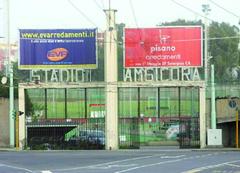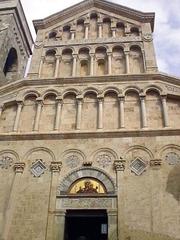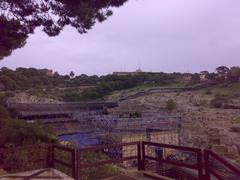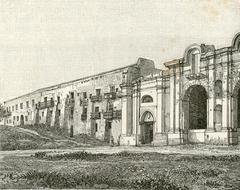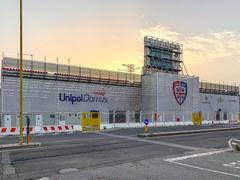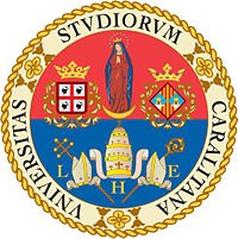Tuvixeddu Necropolis: Visiting Hours, Tickets, and Historical Significance in Cagliari
Date: 04/07/2025
Introduction
Perched atop one of Cagliari’s iconic seven hills, the Tuvixeddu Necropolis is the Mediterranean’s largest Punic burial site and a window into Sardinia’s ancient Carthaginian and Roman past. Spanning approximately 18 hectares, its hundreds of limestone burial shafts—known as “tuvus” after the Sardinian word for “small hole”—make Tuvixeddu a unique archaeological treasure, reflecting centuries of evolving funerary customs and Mediterranean cultural exchange (Estate in Sardegna). Today, the necropolis is both a protected archaeological park and an accessible destination for visitors eager to explore Cagliari’s layered history.
This comprehensive guide details Tuvixeddu’s origins, practical visitor information (including hours, tickets, accessibility, and guided tours), and tips for making the most of your visit. Whether you are a history enthusiast, traveler, or student, Tuvixeddu offers an immersive journey through Sardinia’s ancient civilizations.
Table of Contents
- Historical Background
- Visiting Tuvixeddu Necropolis: Essential Information
- Layout and Highlights
- Nearby Attractions
- Frequently Asked Questions (FAQ)
- Summary and Visiting Tips
- References and Further Reading
Historical Background
Origins and Early Development
Tuvixeddu Necropolis originated in the 6th century BCE, serving the Carthaginian (Punic) community settled between the present-day Sant’Avendrace district and the Santa Gilla lagoon. The limestone hill’s soft rock allowed for deep shaft tombs, while its elevation gave the site strategic spiritual and social importance (CagliariMag).
Punic Burial Practices and Tomb Architecture
The necropolis comprises over 1,100 Punic shaft tombs (“tombe a pozzetto”), some descending 11 meters. Each shaft leads to a burial chamber, often reused by families over generations. Notably, select tombs feature rare wall paintings depicting the goddess Tanit and other religious motifs—unique within the Punic world (Estate in Sardegna). Amulets, jewelry, amphorae, and figurines found here reflect Carthaginian funerary rituals and social stratification.
Roman Expansion and Transformation
Following the Roman conquest in 238 BCE, the necropolis expanded with new tomb types, including chamber tombs, columbaria, and mausolea. The Grotta della Vipera is a standout Roman-era tomb featuring Latin inscriptions and a legendary love story (Estate in Sardegna; Cagliari Turismo).
Modern Rediscovery and Conservation
After centuries of looting, urban encroachment, and even use as WWII air-raid shelters, systematic excavations began in the late 19th century. Conservation efforts since the late 20th century have transformed Tuvixeddu into a protected park, balancing archaeological preservation with public access (Official Tuvixeddu Archaeological Park Website).
Visiting Tuvixeddu Necropolis: Essential Information
Location and How to Get There
- Address: Via Falzarego, Sant’Avendrace district, Cagliari, Italy (Cagliari Turismo)
- By Foot: 25–30 minutes uphill from central squares such as Piazza Yenne or Piazza Matteotti.
- By Car: Follow Viale San Vincenzo to Piazza d’Armi, then Viale Merello, Via Vittorio Veneto, and Via Falzarego. Limited free parking is available (Strictly Sardinia).
- By Bus: CTM lines 1 and 9 from Piazza Matteotti; alight at Via Cesare Battisti (Strictly Sardinia).
Opening Hours
- January–March: 6:00 am – 9:00 pm
- April–September: 5:30 am – 10:30 pm (extended to midnight in July–September)
- October–December: 6:30 am – 10:00 pm (Sardegna in Blog)
Tickets and Guided Tours
- Admission: Free for all visitors (Strictly Sardinia)
- Guided Tours: Friday–Sunday, 9:00 am–6:00 pm. Multilingual tours available. Reservations required for other days (+39 339 6130531 or +39 340 0888334) (Sardegna in Blog).
Accessibility and On-Site Facilities
- Terrain: Uneven gravel paths and steps; limited wheelchair access.
- Signage: Large bilingual maps at entrance; limited signage at individual tombs (Unione Sarda).
- Restrooms: Not available inside the park.
- Seating/Shade: Limited benches and shade; bring sun protection.
Layout and Highlights
Key Tombs and Areas
- Phoenician-Punic Sector: Vertical shaft tombs with painted chambers; features wall art of palm trees, masks, and goddess Tanit (Cagliari Turismo).
- Roman Sector: Repurposed Punic tombs, columbaria, and mausolea; Grotta della Vipera with Latin inscriptions (The Brain Chamber).
- Notable Tombs:
- Tomb of Sid: Depicts a Sardinian-Punic deity (Sardegna Italia Guida).
- Tomb of the Uraeus: Winged cobra relief, symbolizing protection (Cagliari Turismo).
- Tomb of the Fighter/Wheel: Distinguished by preserved paintings (Wikipedia).
Artifacts and Museum Connections
Artifacts such as amphorae, jewelry, and funerary goods are exhibited at the National Archaeological Museum of Cagliari—a recommended complementary visit (Strictly Sardinia).
Visitor Tips
- Best Visiting Times: Early morning or late afternoon to avoid heat.
- Duration: 1–1.5 hours; guided tours last 90 minutes.
- Preparation: Wear sturdy shoes, bring a hat, sunscreen, and water.
- Safety: Uneven ground and open shafts—supervise children.
- Language: Most signage is in Italian; consider a guide or guidebook for deeper understanding.
- Cleanliness: Some litter issues persist; improvements are ongoing (Unione Sarda).
Nearby Attractions
- Roman Amphitheatre: 2nd-century CE, near Tuvixeddu (Sardegna Italia Guida).
- Villa di Tigellio: Roman villa ruins with mosaics.
- Orto Botanico di Cagliari: Botanical garden, 15-minute walk (Trek Zone).
- National Archaeological Museum: Displays Tuvixeddu artifacts.
Frequently Asked Questions (FAQ)
Q: Are tickets required?
A: No, admission is free.
Q: What are the opening hours?
A: Hours vary seasonally, generally from early morning to late evening, with extended summer hours.
Q: Is the site wheelchair accessible?
A: Accessibility is limited due to uneven terrain and steps.
Q: Are guided tours available?
A: Yes, mainly on weekends or by reservation.
Q: What is the best time to visit?
A: Early mornings or late afternoons.
Summary and Visiting Tips
Tuvixeddu Necropolis is an invaluable relic of Sardinia’s ancient Mediterranean heritage. Its extensive Punic and Roman-era tombs, funerary art, and artifacts provide deep insight into evolving burial customs and social hierarchies. Modern conservation has transformed Tuvixeddu into a protected natural park, offering educational programs, special events, and panoramic views of Cagliari (Official Tuvixeddu Archaeological Park Website; Strictly Sardinia). Visitors can enhance their experience by utilizing digital resources like the Audiala app and by exploring nearby landmarks such as the National Archaeological Museum. Tuvixeddu’s integration into Cagliari’s cultural tourism circuit, alongside local cuisine and festivals, makes it a compelling stop for any traveler.
References and Further Reading
- Tuvixeddu La Necropoli Punica di Cagliari tra Storia e Archeologia – Estate in Sardegna
- Tuvixeddu Necropolis Sardinian Archaeological Site – CagliariMag
- How to Visit Tuvixeddu Sardinia – TheTravel
- Tuvixeddu Necropolis Visitor Guide – Official Tuvixeddu Archaeological Park Website
- Tuvixeddu Necropolis – Cagliari Turismo
- Tuvixeddu Necropolis Guide – Strictly Sardinia
- Journey to the Tuvixeddu Necropolis – Unione Sarda
- Necropoli Tuvixeddu Anfiteatro Romano Cagliari Orari Visita Prezzi Biglietti – Sardegna in Blog
- Tuvixeddu Necropolis – Sardegna Italia Guida
Ready to discover Tuvixeddu Necropolis? Download the Audiala app for audio guides and up-to-date visitor information. Follow us on social media for news, events, and exclusive content about Sardinia’s rich archaeological heritage.
